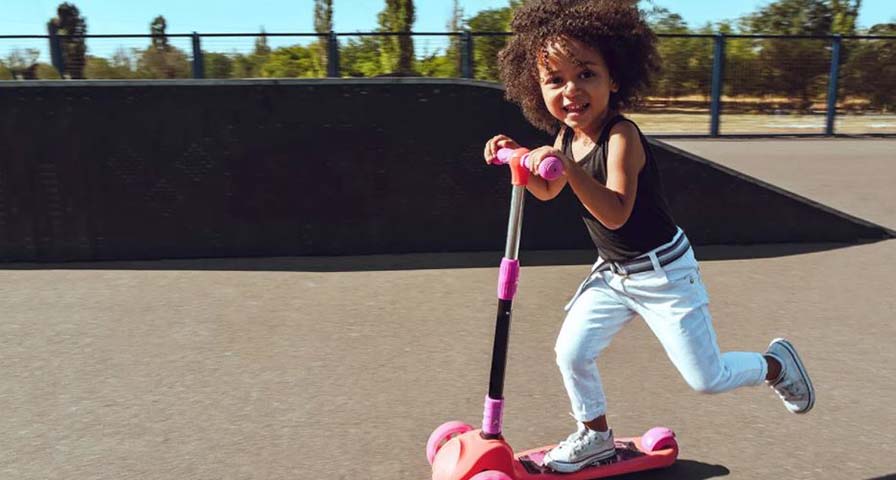Originally published June 21, 2021 by Healthline.
By Sara Linberg with Mia Armstrong, MD
Nurturing a lifelong love of movement and physical activity in children is a goal of many parents and caregivers. Unfortunately, less than 24% of American children ages 6 to 17 get 60 minutes of physical activity daily, which is the recommended amount for kids.
The good news? When children develop a love for something like movement early on, it usually sticks with them for life. To ensure your child gets enough exercise as they get older, you need to set a foundation for a lifelong appreciation for movement in their early years.
 The love of movement starts at home
The love of movement starts at home
The foundation you set with young children is critical to their overall health.
Denise Woodall-Ruff, MD, Pediatrician, and Director of the Healthy Weight & Wellness Center at Stony Brook Children’s Hospital, says that children model the actions of their parents and other major role models in their lives when it comes to a multitude of lifestyle behaviors, including physical activity and fitness habits.
“A child that observes a parent or role model engage in a healthy level of physical activity is more likely to accept these behaviors for themselves,” she says. “Similarly, a child that observes their caregiver sit on the couch for prolonged periods and engage in sedentary behaviors is more likely to accept these behaviors as their norm,” adds Woodall-Ruff.
Natasha Trentacosta, MD, Pediatric and Adult Sports Medicine Specialist and Orthopedic Surgeon at Cedars-Sinai Kerlan-Jobe Institute in Los Angeles, agrees. “Parents, caregivers, and educators are role models for young children, as kids look up to these people to set an example of how to navigate life,” she says.
“Children who regularly see their parents partaking in sports and fitness activities are more likely to do it themselves — this is especially true now as screen time is increasing among young children and physical activity is decreasing,” says Trentacosta. Establishing healthy habits early in life will stay with them as they grow.
How to inspire a love of movement
The key to inspiring a love of movement from an early age is to keep the focus on having fun. Just like adults, kids are less likely to get excited about something they don’t enjoy. Plus, if they’re having fun, they’ll probably want more of it, which gives them time to practice skills and improve their abilities.
“Every child is unique, and some gravitate toward exercise and physical activity more than others,” says John Gallucci Jr., DPT, ATC, and CEO of JAG-ONE Physical Therapy.
That’s why it’s essential to find activities that your child enjoys and turn them into activities that encourage them to move more. “Children, especially young kids, should not feel as if exercise is a chore,” says Gallucci.
As kids get older and more involved in organized sports, keep in mind that some kids love structured sports and competition, but many others do not. Keep a broader definition of movement that includes walks with the family, dancing in the living room, tree climbing, yoga, or any other things they enjoy.
Getting kids interested in movement and physical activity at a young age increases the likelihood that they’ll reap all of their benefits sooner, and their interest in exercise will likely continue to build as they grow.
Tips for getting started
Providing opportunities for movement each day is critical for your child’s physical, mental, and emotional development. It also helps set the stage for active participation in fitness activities as an adult.
Here are 12 tips to help you inspire a love of movement from an early age.
Make sure the activity is age-appropriate
Asking a 3-year-old to participate in a family game of badminton might not be the best way to encourage movement. However, lowering the net and giving them a preschool-size racket with a large ball increases success and improves the fun factor.
Focus on motor skills
Developing gross motor skills is critical for children, especially preschoolers. These skills help kids with balance, strength, coordination, and reaction time.
If you have toddlers and preschool-age kids, keep activities centered around kicking or throwing a ball, hopping, climbing, obstacle courses, or riding a trike or bike with training wheels.
Be sure they wear helmets and other protective gear when riding bikes, and adequately supervise them when they’re climbing or using moving toys or devices.
Make active toys available
When choosing indoor and outdoor toys, include items that require active play, such as balls for young children and bikes and scooters for older kids. Climbing toys are an excellent choice for toddlers, preschool, and school-age children, just make sure they are age-appropriate.
Aim for more active toys than passive toys at home. When your child asks for a new toy, have them donate a passive toy in exchange for a new active toy. This tips the scales in favor of movement and teaches them that less is more.
Encourage free play
Free play is how kids learn about themselves and their environment. It’s also an excellent time to sneak in some exercise.
Make sure to include several free-play opportunities throughout the day. To keep the play active, encourage your child to go outdoors for 30 minutes and use their imagination to create an obstacle course or scavenger hunt, ride a bike or scooter, or play with balls and other outdoor toys.
Get active with your kids
Telling kids of any age to “get some exercise” does not always work. Yet, if you get active with your children, they’re more likely to want to participate. Plus, this can be a time-saver for working parents who want to exercise but struggle with being away from their kids outside of the workday.
Create an activity schedule
Woodall-Ruff recommends a weekly physical activity schedule with goals. This is something you should do together and post it in a common location. Decide — with your child — on a nonfood-related reward when they meet that goal.
Talk about fitness
If you want to inspire your kids to love movement, you need to teach them what it means. Look for opportunities to create a positive culture of fitness at home. Talk about your workouts, sports, and activities and how important they are in your life. At the dinner table, discuss food and how it fuels movement.
Turn chores into exercise
Pairing chores with active competitions accomplishes two things: your child completes a household task and they get exercise while doing it. If you have more than one child, turn chores into a competition that involves exercise.
For example, toddlers and preschool-age kids can race to see who can throw their laundry into the basket the fastest. Outside, make a competition out of picking up the yard or weeding the garden. Designate a section of the yard for each child (and parent) to clean up. The person who finishes first wins.
Let them choose the activity
Even young kids know what they like, and they certainly feel appreciated when you ask them about it. Let your child choose a few activities or sports they enjoy, and participate in them as a family.
Read a movement-inspired story
Bookstores and libraries are full of books that encourage movement in young children. Gather some of them and let your child choose two or three to bring home. Here are some titles to get you started:
- “Yoga Bug” by Sarah Jane Hinder
- “The Yoga Zoo Adventure” by Helen Purperhart
- “Get Up and Go” by Nancy Carlson
Sign up for an activity-based preschool
If you need childcare or plan to send your little one to preschool, look for places that make movement and fitness a significant part of the day.
Try an organized sport
When kids are old enough, you might consider enrolling them in an organized sport. The American Academy of Pediatrics says most children are ready for simple, organized sports at age 6 (3).
Group sports like soccer and tee-ball have age brackets that tailor the game to a child’s age and level, allowing them to practice new skills while learning about competition.
Physical activity guidelines for kids
The Centers for Disease Control and Prevention (CDC) recommends that kids participate in physical activity for 60 minutes or more each day.
More specifically, the Physical Activity Guidelines for Americans provides a framework of exercise guidelines for parents and caregivers to follow based on age groups.
Preschool-age children
Young children ages 3 through 5 should get plenty of physical activity throughout the day. The goal of movement at this age is to enhance growth and development. Preschool-age children should have exposure to a variety of activities and active play. Variety is the key when kids are young.
School-age youth
Children, adolescents, and teens ages 6 through 17 should participate in moderate to vigorous intensity exercise for at least 60 minutes each day. This does not have to be at one time. Encourage kids to break the 60 minutes up into chunks.
For example, 20 minutes of practicing soccer, 20 minutes of bike riding, and 20 minutes of physical activity at school. Remember, any amount of moderate to vigorous exercise and movement counts toward the physical activity guidelines.
Ideally, school-age youth should engage in aerobic, muscle strengthening, and bone-strengthening activities. However, most of the 60 minutes each day should be aerobic or cardiovascular activity. They can include muscle and bone-strengthening exercises like resistance training on three days of the week.
Examples of aerobic activity for preschool-age kids include tag, follow the leader, playing on a playground, bike riding, walking, skipping, dancing, swimming, throwing and catching games, and tumbling.
Meanwhile, aerobic activities for school-age children and adolescents include running, bike riding, sports, martial arts, dancing, catching and throwing games, hiking, swimming, tag, and flat football.
Link between childhood movement and physical fitness in adulthood
Children that develop healthy physical activity habits have a greater potential of maintaining those habits as an adult.
Research shows that physical activity improves heart health, promotes bone and muscle strength, and helps you maintain a healthy weight.
Woodall-Ruff says these fitness benefits in children can translate into healthier outcomes in adulthood.
A large observational study including over 48,000 postmenopausal women found that higher levels of self-recalled childhood physical activity levels were associated with higher activity levels in adulthood.
More specifically, women who were active as children participated in higher levels of physical activity as adults, with most averaging 2.8 metabolic equivalent (MET) hours per week more than women who were always inactive during childhood (7Trusted Source).
Another study found that participation in sports at age 10 was associated with increased physical activity at age 42. Yet, this study also looked at outdoor play at age 10 as a predictor of physical activity in adulthood and found that, unlike sports participation, outdoor play at age 10 was not associated with participation in physical activity at age 42 (8Trusted Source).
Physically active children are more likely to become active adults and typically lead healthier lifestyles as they age.
“When exercise and physical activity are introduced at a young age, research has suggested that confidence in the person’s abilities and an interest in a healthier, more fit lifestyle are established early on and then carried through for the remainder of their life,” says Gallucci.
The bottom line
Perhaps one of the best things you can do for your children’s health is to get them moving — and from a young age.
Doing so will not only help them succeed in school and stay healthy in their school years but also help foster a love of movement throughout their entire life.
Learn How the IHT Spirit System Encourages Physical Activity in School-Age Children:




